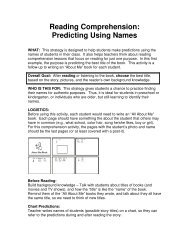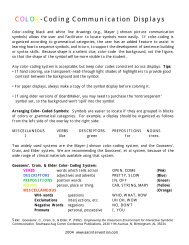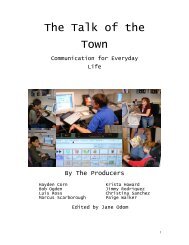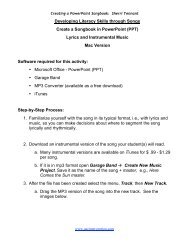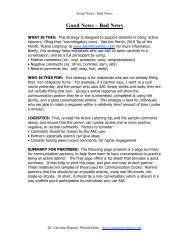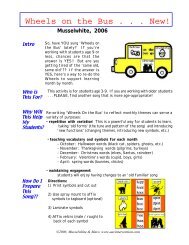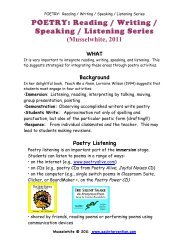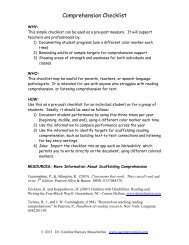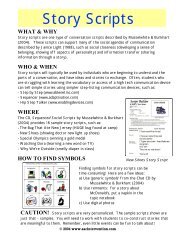SABOTAGE!! - AAC Intervention.com
SABOTAGE!! - AAC Intervention.com
SABOTAGE!! - AAC Intervention.com
You also want an ePaper? Increase the reach of your titles
YUMPU automatically turns print PDFs into web optimized ePapers that Google loves.
<strong>SABOTAGE</strong>!!<br />
by Caroline Musselwhite<br />
WHAT AND WHY?<br />
Goossens’, Crain, & Elder (1992) have developed excellent<br />
ideas for using sabotage as a strategy to promote initiation<br />
of <strong>AAC</strong> use, whether light or high tech. This tip shares<br />
their ideas, and adds some new tips. Sabotage refers to<br />
creatively managing the environment so that there is a<br />
NEED to <strong>com</strong>municate. It can be highly motivating and fun,<br />
and well as an effective way to support students in learning<br />
or practicing <strong>com</strong>municative functions.<br />
WHEN TO <strong>SABOTAGE</strong>?<br />
Sabotage is especially appropriate for ‘process activities’ such as:<br />
• cooking<br />
• art<br />
• science experiments<br />
HOW TO <strong>SABOTAGE</strong>?<br />
1) Make a Plan! Think ahead, deciding what types of sabotage you will use, and who to<br />
sabotage. This is based on student needs and abilities, not on whims. For example:<br />
- Alicia seems to notice when something goes wrong in a cooking or art activity, as she<br />
looks and laughs. Use this as an opportunity to help her <strong>com</strong>ment on actions (OOPS /<br />
UH-OH!)<br />
- Melodie likes to have a turn, but is having a hard time finding vocabulary on her<br />
<strong>com</strong>munication device. Support her in learning to request recurrence (asking for MORE)<br />
at various stages in the cooking or art activity<br />
- Marcus already knows how to <strong>com</strong>ment and request recurrence so we want to move him<br />
forward. Today, we will support him in protesting (NO! NOT CUP) or requesting action<br />
(GET BOWL / PUT IN OVEN / OPEN IT)<br />
2) Set the Stage! Think ahead to items you should place:<br />
- out of reach - out of sight - in another room (to require going for help)<br />
3) Designate a ‘Stooge’!<br />
a) With younger students, consider using a ‘helping doll.’ This is a large doll who can<br />
assist you in getting materials, performing actions. She can either be a great model . . .<br />
or a fabulous mix-up. The doll can get wrong ingredients, etc.<br />
b) For older students, enlist a peer tutor or a paraprofessional to make mistakes.<br />
© 2005 www.aacintervention.<strong>com</strong>
WHAT TYPES OF <strong>SABOTAGE</strong>?<br />
INCORRECT ITEM:<br />
Description: Leader uses <strong>AAC</strong> device / overlay to request<br />
object (GET BOWL, or WE NEED BOWL). Helper gets<br />
incorrect item.<br />
Possible Language to Elicit:<br />
<strong>com</strong>ment on action (UH-OH!)<br />
protest / negate (NO! NOT CUP!)<br />
request action (GET BOWL; WE NEED BOWL)<br />
“Put on frosting.”<br />
MISSING ITEM:<br />
Description: Leader uses <strong>AAC</strong> device / overlay to<br />
request action (PUT ON FROSTING). However, item to<br />
<strong>com</strong>plete action is missing (ex: no knife).<br />
Possible Language to Elicit:<br />
<strong>com</strong>ment on action (UH-OH!)<br />
protest / negate (NO KNIFE; DON’T HAVE<br />
KNIFE)<br />
request action (NEED KNIFE)<br />
request information (WHERE KNIFE?)<br />
OMITTED STEP:<br />
Description: Leader uses <strong>AAC</strong> device / overlay<br />
to request action (PUT MIX IN BOWL).<br />
However, a step is missing.<br />
Possible Language to Elicit:<br />
<strong>com</strong>ment on action (UH-OH! / OOPS!)<br />
protest / negate (NO BOX IN BOWL!)<br />
request action (OPEN IT)<br />
“Put the<br />
mix in the<br />
bowl.”<br />
“Open the<br />
box.”<br />
INCOMPLETE STEP:<br />
Description: Leader uses <strong>AAC</strong> device / overlay<br />
to request action (OPEN BOX). However, the<br />
action is not <strong>com</strong>pleted (ex: open just a bit).<br />
Possible Language to Elicit:<br />
<strong>com</strong>ment on action (UH-OH! / OOPS!)<br />
request recurrence (OPEN MORE)<br />
Goossens', C, Crain, S, & Elder, P. (1992). Engineering the Classroom Environment for Interactive Symbolic<br />
Communication -- An Emphasis on the Developmental Period, 18 Months to Five Years, Southeast Augmentative<br />
Communication Conference Publications, 2430 11th Avenue, N, Birmingham, AL 35234.



